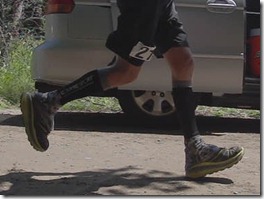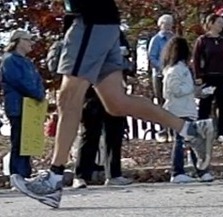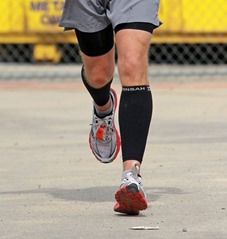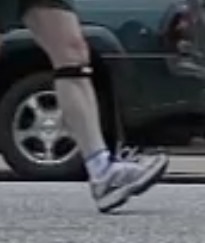 A friend on Twitter (thanks Josh N.!) forwarded me a link to a post on the Sharman Ultra blog that discusses research results from the 2012 Western States Ultramarathon.
A friend on Twitter (thanks Josh N.!) forwarded me a link to a post on the Sharman Ultra blog that discusses research results from the 2012 Western States Ultramarathon.
A group of researchers had set up a study to look at foot strike patterns and stride characteristics of runners at several points in the race, and the post provides the text of an email summarizing their results (the blogger, Ian Sharman, had run in the race). In a nutshell, here’s what they found:
1. 80-90% of runners were heel strikers at all four locations where they analyzed foot strike patterns (10.2 miles, 56.1 miles, 56.4 miles, 100.1 miles). This is in-line with data I have published on marathon runners.
2. Excluding the downhill analysis point, stride length was longest at the earliest examination point (10.2 miles).
3. No relationship was observed between foot strike pattern and performance (I found the same among marathoners).
Making the likely assumption that all of these runners were shod, and that most were wearing somewhat cushioned shoes, these results don’t surprise me and are in line with my own findings on foot strike patterns among shod runners in a road marathon (I also did a bit of filming at the VT100 this year and would guess the results would have been similar there). It may turn out that in some of the locations heel striking in trail ultramarathoners was a bit less common than in road marathoners (I observed 88.9% heel strikers at the 10K point of a road marathon), but we’d need the raw numbers to address that (not just a range).
It’s also important to note that neither this nor my study examined variation among heel strikers – there is a great deal of variety in the amount of dorsiflexion at ground contact among heel strikers, and lower limb orientation is also highly variable – heel striking isn’t really a category so much as a spectrum that encompasses a wide range of variability.
What I like about studies like this is that they provide data on what runners in the “real world” do outside of an artificial lab environment. This study provides further evidence that when distance runners wear shoes, even those who run huge mileage on trails, they tend to land on their heels most of the time. The results don’t provide insight on whether heel striking is good or bad, and if anything they suggest that at least from a performance standpoint it doesn’t much matter how your foot contacts the ground. All of this contributes to my belief that as long as it’s not too extreme, it’s OK to be a heel striker!


















Whoa.
I am super distracted by how HUGE those shoes are!
Amazing, isn’t it! Lots of runners wearing them at the VT100.
—-
Pete Larson’s Web Links:
My book: Tread Lightly – link to ow.ly
Blog: https://runblogger.com
Twitter: link to twitter.com
Facebook: link to facebook.com…
HOKA have marketed themselves really effectively in the ultra scene in the past year. I personally find them hideous, both to look at and conceptually.
I do wonder if they are selling to a those that wants a quick and easy solution to foot discomfort. Going the minimalist route by contrast specifically is about increased ground feel and requires foot and low leg strengthening.
Long term I can’t help but feel the HOKA runners are going to become weaker, less coordinated and more injured because of the lack of quality feedback.
While short term (first few years) the minimalist will probably be the ones suffering more during transition, but longer term should be better off.
I have a ultrarunner friend with chronic plantar fasciitis and the Hokas are the only shoes that let him run the miles he needs to run. He prefers minimalist shoes, but sometimes you’ve gotta go with what works to keep moving forward.
—-
Pete Larson’s Web Links:
My book: Tread Lightly – link to ow.ly
Blog: https://runblogger.com
Twitter: link to twitter.com
Facebook: link to facebook.com…
I have actual thought about the possibility that a largely rigid sole with significant rocker built into the shoe might be good for alleviating stress on the plantar fascia. I believe this will be because the toes will never flex significantly late on stance, and the rocker the center of pressure on the foot would stay further aft late on stance.
The HOKA fits this model of shoe quite well, the foot is effect isolated from the ground and the normal motions and loading we’d place on our feet.
While the HOKA might alleviate the stress on the plantar fascia and allow one to keep running. Allowing a foot to have a relative rest may help helping in the short term.
With a longer term injury I believe one would need to actively stress the plantar fascia to encourage strengthening of the plantar fascia. This looks to be what helped you overcome you plantar fascia problems.
For me resting up doesn’t seem to help too much, and doing too many up hills and steep descents causes a regression so I’m trying to slow increase the amount of hills and the stimulus for adaptation.
This is all assuming the problem is actually plantar fasciitis. I’m not so sure in my case – I’ve had a recent recurrence and I think it is all related to my calves – my mileage has dropped dramatically of late and I’ve tightened back up, which is what I think has brought a return of the morning pain…
—-
Pete Larson’s Web Links:
My book: Tread Lightly – link to ow.ly
Blog: https://runblogger.com
Twitter: link to twitter.com
Facebook: link to facebook.com…
I had posterior tibialis dysfunction manifest as what I thought was plantar fasciitis. Rather than appearing in the medial shin or ankle, it occurred at its distal attachment, so I ended up feeling it in my arch, and I initially thought it was PF. Just a possible differential diagnosis to consider…it would be consistent with your description of being related to your calves, and since it slows pronation, you may feel it in the morning when you step out of bed and go from an unloaded, shortened position (I’m assuming you sleep plantarflexed and not with a Strassburg sock or similar) to a loaded, lengthened position.
Yes, no sock. I lean toward calf because a good soleus stretch usually eases the ache immediately.
Sent from my iPad
I have no desire to try them but I wonder if HOKAs work because there’s so much cushioning that they’re more resistant to compression along the edge of the midsole.
Maybe the problem with neutral cushioned shoes for some people is the
steep heel-to-toe offset combined with cushioning that is just plentiful and soft enough
to be “unstable”. The HOKA does have a fairly low drop that’s similar to minimalist shoes.
I think you might be on to something. I’ve been running in the Hokas for a few months now, and I have several hundred miles on them. It’s a weird ride at first. They feel like they have both elements of stability and instability at the same time. I wore orthotics for years, and yet I don’t need them in the Hokas. Also, I suffered from achilles tendonitis that was getting debilitating, and now it seems to be clearing up. I’ve gone from 3 days per week to 5 days running. I perceive more of a forefoot strike, although as we know what you perceive or believe about your footstrike is rarely true. My feet has always been sensitive and react badly when the mileage gets up to about 30 miles per week. I’ve tried all of the known brands and styles of shoes. I just about wrecked my feet in Nike Frees. From the recent minimalist movement, excessive cushioning seems to have been demonized. But maybe the current crop of shoes is simply implementing cushioning wrongly. Perhaps the Hoka way of doing cushioning is the correct implementation. And it looks like New Balance has got a Hoka clone on the way. We shall see.
I’m really tempted to try Hokas, but the price tag is a bit high still. Really want to write them up!
—-
Pete Larson’s Web Links:
My book: Tread Lightly – link to ow.ly
Blog: https://runblogger.com
Twitter: link to twitter.com
Facebook: link to facebook.com…
Hoka pricing is currently ridiculous. They’re probably not big enough to have economies of scale, and they have something unique so they can charge for it. The shoe itself appears very simple. Appears to be a monolithic midsole, with no posting or other features. The upper is not up to par with the big guys yet, but it is certainly functional. There will be competition and the prices will drop.
They are not the Frankenstein shoes people think they are. The heel drop is only 4mm. On the trails and street they really are fatigue sparing. At 11.5 oz, I do wish they were lighter. I’d love to see a Kinvara-weight Hoka with zero drop.
From my own experience, I know that I heel strike in typical 12-10mm dropped shoes. But I mid foot strike in 4mm shoes. It’s automatic. I’m not consciously doing anything different.
So if heel-toe drop in footwear is such a significant factor in foot strike, then a foot strike study that doesn’t take footwear into account isn’t very meaningful in my opinion.
It looks like they were measuring other things as well, but as far as looking at foot strike without considering footwear, it just seems pointless.
I would agree – footwear matters. However, I would imagine a fair number of the runners they observed were probably wearing shoes in the 4mm range, things like the Salomon Sense, New Balance MT110, etc. Unless they have consciously tried to work on form, I don’t think shoes like those are enough to change things on their own. There is a big motor learning component to form change, and I think for most people it requires more than just changing shoes. I have some interesting data that I need to publish that would support this.
—-
Pete Larson’s Web Links:
My book: Tread Lightly – link to ow.ly
Blog: https://runblogger.com
Twitter: link to twitter.com
Facebook: link to facebook.com…
Isn’t it possible that the foot in these apparent heel-strikers actually experiences the most load a split second later when the foot is completely on the ground, and the body directly above?
People can debate this all they want, but all I know is that people like Anton Krupicka don’t heel strike, and going the minimal, barefoot-style route has taken me from being a really shitty runner to a much better one who can run a lot farther with no discomfort.
Yes, exactly, which is why I said all heel strikes are not the same. Some people touch briefly on the heel then go flat, probably before any major loading occurs. Others crash down on a foot that is angled 45 degrees from the ground. Ultimately all that really matters is what works best for each of us on an individual level, but I think understanding general patterns of what people do can be helpful.
—-
Pete Larson’s Web Links:
My book: Tread Lightly – link to ow.ly
Blog: https://runblogger.com
Twitter: link to twitter.com
Facebook: link to facebook.com…
Thanks for the reply, and thanks for the great website. I know I am not alone in saying that your attention to detail is much appreciated.
Hi Pete, just for some information I am carrying out some in shoe pressure analysis and video testing on one of our elite runners in HOKA’s this week, we are going to do a very basic comparison of the HOKA’s against minimalist and traditional running shoes. He has been wearing HOKA’s for a couple of years and finds that these shoes allow him to compete (and often win) ultras without the foot pain he used to get. We shall look to see if any difference in contact position on the foot, where the foot appears to be fully loaded in comparison to the rest of the body, leg extension at toe off and heel lift through swing.
it will be intersting to see if the shoe itself actually changes any of these without the runner thinking too hard about what it going on – as I said a basic look rather than full scientific study, but may provide some useful feedback when we are selling shoes.
Cool, would love to see the results! A good friend of mine also swears by the Hokas for his foot pain – use what works is my philosophy.
—-
Pete Larson’s Web Links:
My book: Tread Lightly – link to ow.ly
Blog: https://runblogger.com
Twitter: link to twitter.com
Facebook: link to facebook.com…
When running on trails I adopt a more deliberate dorsiflexed heel touch as it tends to be a good method to avoid tripping! When I’ve fallen on trails it’s usually because the toe has caught a rock or tree root. I’m guessing I’d be a less obvious heel ‘striker’ when running on a smooth flat surface. In fact, I think I’m running with a mid-foot strike on such surfaces although still photos often say otherwise. On trails I feel like my toes are up when I land.
just saw this, glad you got to read it! great stuff!